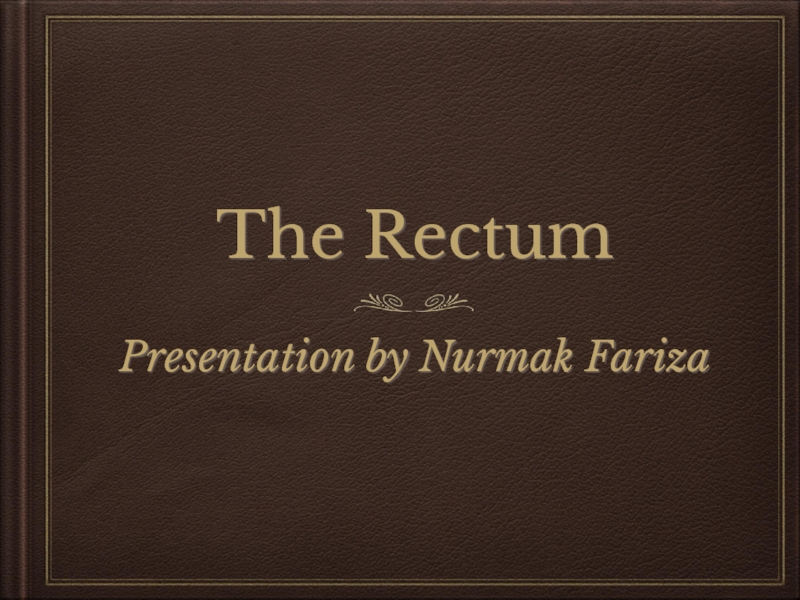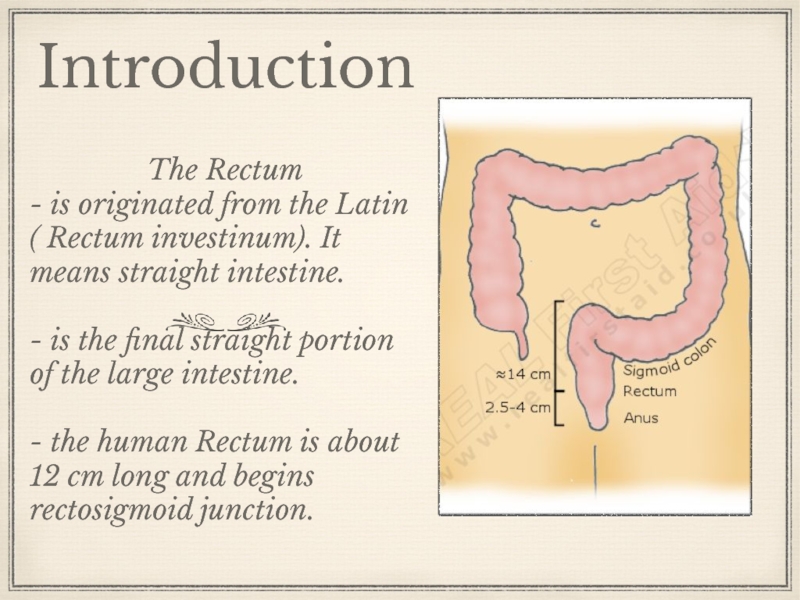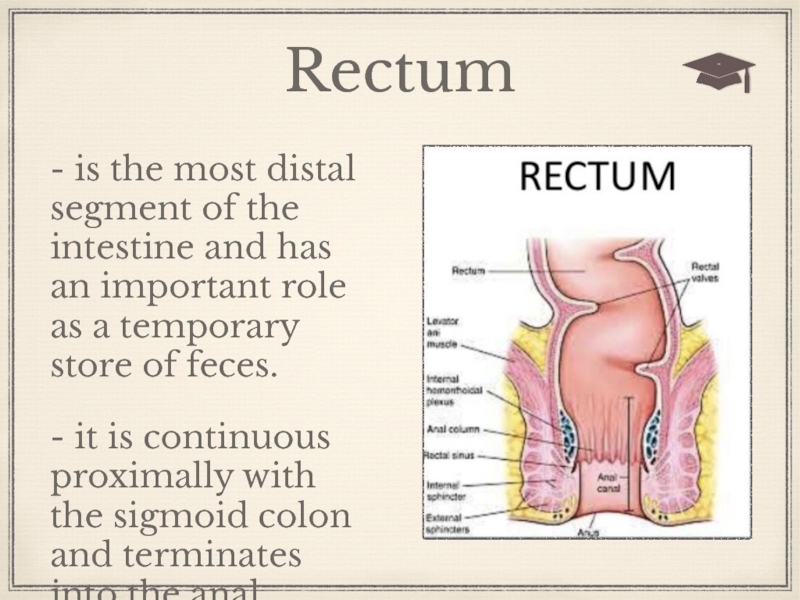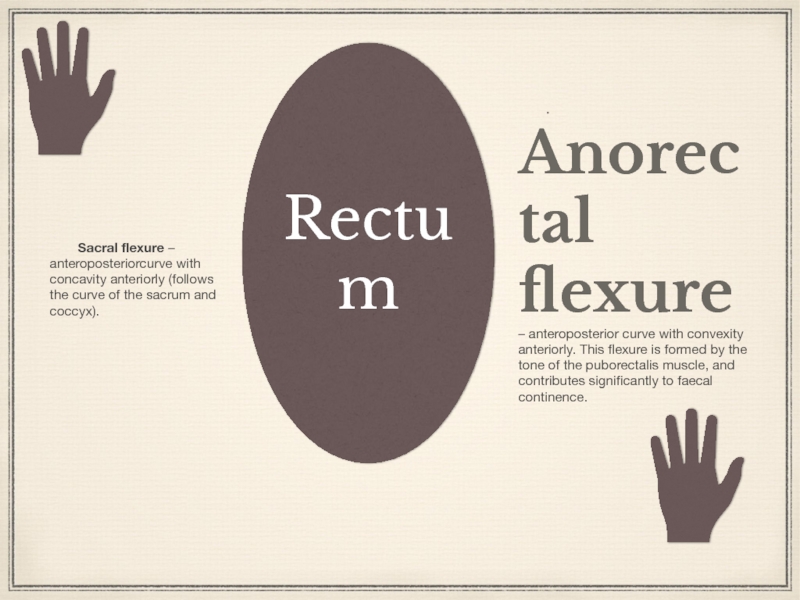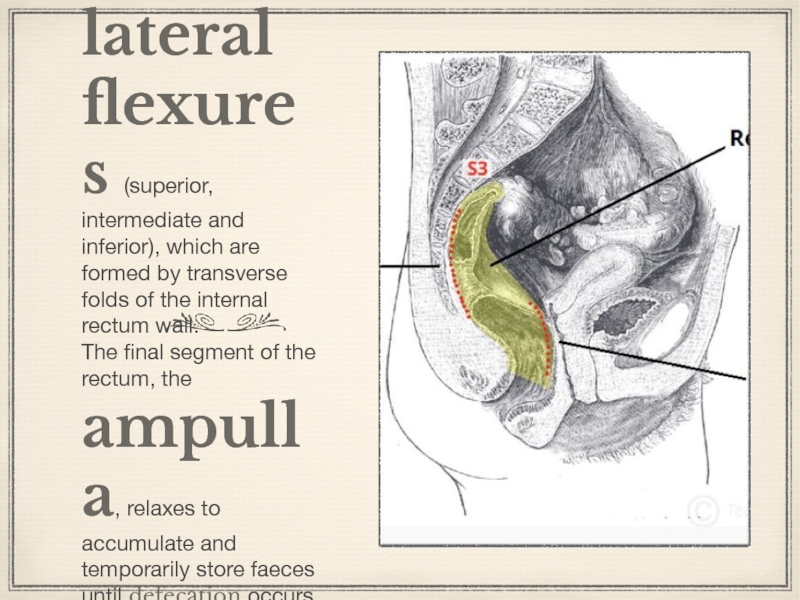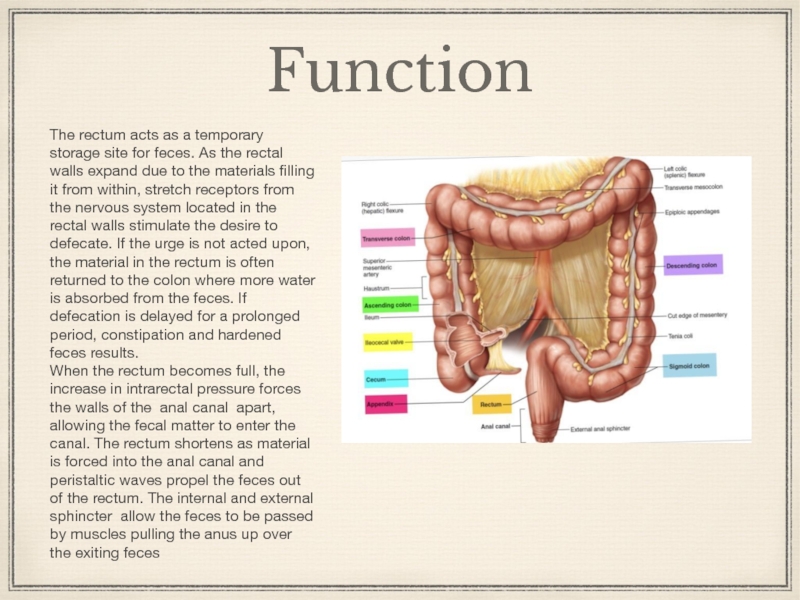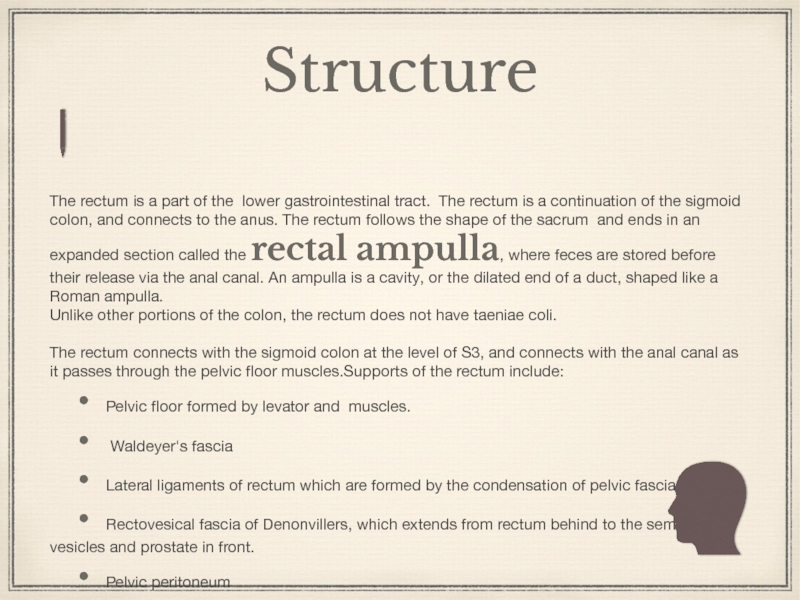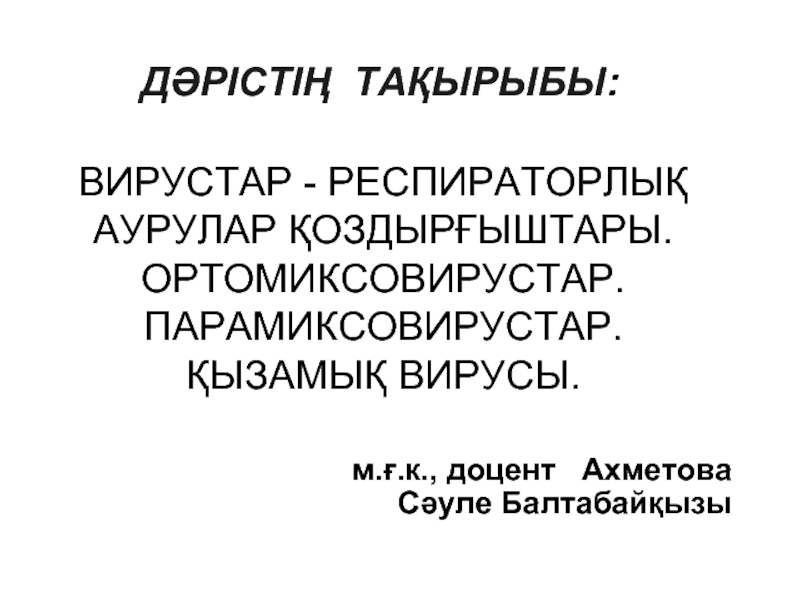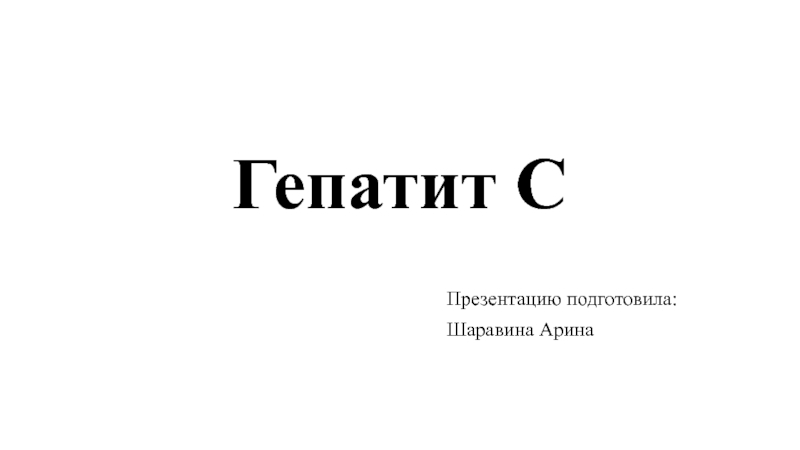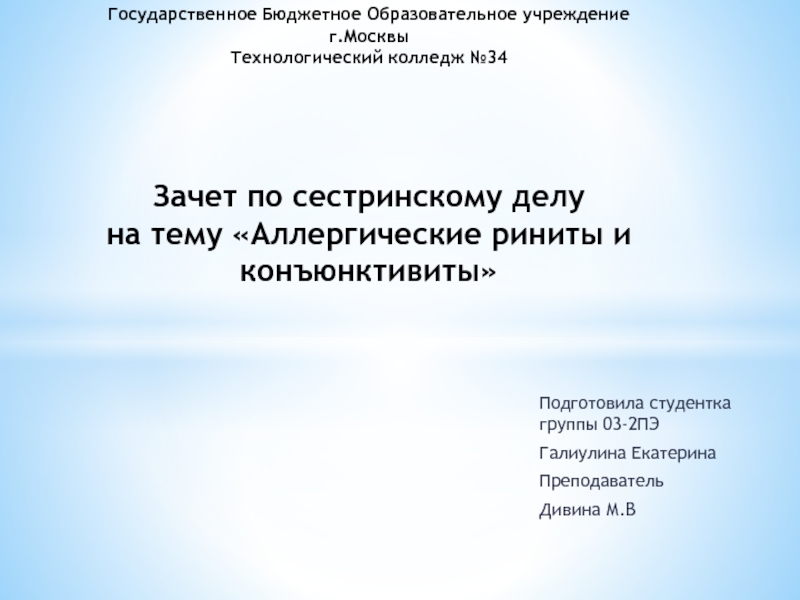- Главная
- Разное
- Дизайн
- Бизнес и предпринимательство
- Аналитика
- Образование
- Развлечения
- Красота и здоровье
- Финансы
- Государство
- Путешествия
- Спорт
- Недвижимость
- Армия
- Графика
- Культурология
- Еда и кулинария
- Лингвистика
- Английский язык
- Астрономия
- Алгебра
- Биология
- География
- Детские презентации
- Информатика
- История
- Литература
- Маркетинг
- Математика
- Медицина
- Менеджмент
- Музыка
- МХК
- Немецкий язык
- ОБЖ
- Обществознание
- Окружающий мир
- Педагогика
- Русский язык
- Технология
- Физика
- Философия
- Химия
- Шаблоны, картинки для презентаций
- Экология
- Экономика
- Юриспруденция
The Rectum. Introduction презентация
Содержание
- 1. The Rectum. Introduction
- 2. Introduction The Rectum - is
- 3. Rectum - is the most distal
- 4. • Anorectal flexure – anteroposterior curve with convexity anteriorly.
- 5. • There are additionally three lateral flexures (superior, intermediate
- 6. Function The rectum acts as a
- 7. Structure The rectum is a part
- 8. Thank you for attention
Слайд 2Introduction
The Rectum
- is originated from the Latin ( Rectum
investinum). It means straight intestine.
- is the final straight portion of the large intestine.
- the human Rectum is about 12 cm long and begins rectosigmoid junction.
- is the final straight portion of the large intestine.
- the human Rectum is about 12 cm long and begins rectosigmoid junction.
Слайд 3Rectum
- is the most distal segment of the intestine and
has an important role as a temporary store of feces.
- it is continuous proximally with the sigmoid colon and terminates into the anal.
- it is continuous proximally with the sigmoid colon and terminates into the anal.
Слайд 4 • Anorectal flexure – anteroposterior curve with convexity anteriorly. This flexure is formed
by the tone of the puborectalis muscle, and contributes significantly to faecal continence.
Rectum
Sacral flexure – anteroposteriorcurve with concavity anteriorly (follows the curve of the sacrum and coccyx).
Слайд 5 • There are additionally three lateral flexures (superior, intermediate and inferior), which are
formed by transverse folds of the internal rectum wall.
The final segment of the rectum, the ampulla, relaxes to accumulate and temporarily store faeces until defecation occurs. It is continuous with the anal canal; which passes through the pelvic floor to end as the anus.
The final segment of the rectum, the ampulla, relaxes to accumulate and temporarily store faeces until defecation occurs. It is continuous with the anal canal; which passes through the pelvic floor to end as the anus.
Слайд 6Function
The rectum acts as a temporary storage site for feces.
As the rectal walls expand due to the materials filling it from within, stretch receptors from the nervous system located in the rectal walls stimulate the desire to defecate. If the urge is not acted upon, the material in the rectum is often returned to the colon where more water is absorbed from the feces. If defecation is delayed for a prolonged period, constipation and hardened feces results.
When the rectum becomes full, the increase in intrarectal pressure forces the walls of the anal canal apart, allowing the fecal matter to enter the canal. The rectum shortens as material is forced into the anal canal and peristaltic waves propel the feces out of the rectum. The internal and external sphincter allow the feces to be passed by muscles pulling the anus up over the exiting feces
When the rectum becomes full, the increase in intrarectal pressure forces the walls of the anal canal apart, allowing the fecal matter to enter the canal. The rectum shortens as material is forced into the anal canal and peristaltic waves propel the feces out of the rectum. The internal and external sphincter allow the feces to be passed by muscles pulling the anus up over the exiting feces
Слайд 7Structure
The rectum is a part of the lower gastrointestinal tract.
The rectum is a continuation of the sigmoid colon, and connects to the anus. The rectum follows the shape of the sacrum and ends in an expanded section called the rectal ampulla, where feces are stored before their release via the anal canal. An ampulla is a cavity, or the dilated end of a duct, shaped like a Roman ampulla.
Unlike other portions of the colon, the rectum does not have taeniae coli.
The rectum connects with the sigmoid colon at the level of S3, and connects with the anal canal as it passes through the pelvic floor muscles.Supports of the rectum include:
• Pelvic floor formed by levator and muscles.
• Waldeyer's fascia
• Lateral ligaments of rectum which are formed by the condensation of pelvic fascia
• Rectovesical fascia of Denonvillers, which extends from rectum behind to the seminal vesicles and prostate in front.
• Pelvic peritoneum
• Perineal body
Unlike other portions of the colon, the rectum does not have taeniae coli.
The rectum connects with the sigmoid colon at the level of S3, and connects with the anal canal as it passes through the pelvic floor muscles.Supports of the rectum include:
• Pelvic floor formed by levator and muscles.
• Waldeyer's fascia
• Lateral ligaments of rectum which are formed by the condensation of pelvic fascia
• Rectovesical fascia of Denonvillers, which extends from rectum behind to the seminal vesicles and prostate in front.
• Pelvic peritoneum
• Perineal body
